Artificial intelligence is dominating many areas, including the construction industry. AI in construction helps stakeholders realize value throughout the project lifecycle. The technology has simplified project designs, bidding, and project monitoring. Besides speeding up many construction-related tasks, like cost estimations, project managers can now identify potential challenges earlier using AI.
Modern construction AI is only in its infancy stage. As AI and machine learning advancements accelerate, we expect to see more robust and stable technology. But first, let’s look at the current AI technology revolutionizing the construction industry.
Key Takeaways
- AI in construction includes BIM, fleet management, predictive analytics, project management, progress monitoring.
- Downtobid's AI automates scope detection, creates personalized invites with 30% response rates, matches subcontractors.
- AI enhances BIM with collision detection, converts 2D to 3D models, improves design accuracy.
- Predictive analytics increases machine lifespan 40%, reduces downtime 50%.
- Future AI will reduce costs, improve safety, enable virtual monitoring, create hybrid workflows.
What are Powerful Examples of AI in Construction Use Today?
AI in the construction industry has vast potential applications. From data analytics and augmented reality to construction project management, AI has assimilated well within the construction industry.
Here are a few powerful examples of various AI construction tools and use cases.
Building Information Modeling (BIM)
Architects and engineers combine AI and building information modeling tools to analyze data and generate flawless designs. Besides producing impeccable designs, the two technologies can identify potential risks and suggest solutions.
AI handles repetitive tasks, like data entry and model population, allowing architects and designers to focus on the creative side. The approach saves more time, reduces errors, and saves costs.
Collision detection is perhaps the biggest win of integrating AI into BIM tools. Engineers traditionally relied on collected data and experience to identify conflicts between different building elements. However, AI-powered BIM tools are equipped with advanced clash detection algorithms. They help identify conflicts between elements like structural components, electrical systems, and plumbing. The design teams can then formulate solutions to these errors, improving construction quality and reducing rework.
AI-powered BIM tools can also translate 2D drawings into precise 3D models instantly. Traditionally, you’d hire a whole team to handle this, which would take weeks. However, the successful BIM-AI integration saves us money we’d spend on these teams and weeks’ worth of work.
Fleet Management
The construction industry relies heavily on trucks to carry loads, equipment to dig, and staff vehicles for transportation. Hiring someone to monitor vehicles’ conditions is expensive and prone to errors.
AI collects and analyzes fleet data to help with decision-making in several ways. The AI-driven metrics help with real-time location tracking to ensure deliveries are made on time. It also examines the data to determine appropriate maintenance schedules to avoid breakdowns.
Predictive Analytics
Construction projects are prone to errors that interrupt work. An AI algorithm analyses data collected by sensors, workers, and historical data to develop predictive analytics. Construction companies use this information to anticipate potential issues and take corrective measures to keep the project running.
Machine downtime is the biggest threat to any construction project. According to a McKinsey report, predictive analytics increases machine lifespan by 40% and reduces downtime by 50%. Implementing predictive maintenance strategies improves project planning, decision-making, and workers’ safety.
Project Management
Project managers are tasked with ensuring the project meets requirements. Handling all these tasks manually is time-consuming and tedious work. Fortunately, artificial intelligence can handle mundane and repetitive tasks like scheduling and resource allocation.
AI works as a personal assistant. Its accuracy leaves little room for errors. It also frees up valuable time and resources, allowing construction workers to focus on specialized areas. For instance, cost analysts can delegate tasks like quantity takeoffs and report generation to AI and focus on tasks like value engineering to improve productivity.
Monitor Progress
AI has reshaped project monitoring in construction. Its ability to process vast amounts of data in real-time helps construction teams monitor progress on site. With this information, the team can promptly identify bottlenecks and take corrective measures. Traditional progress-tracking methods took longer and were prone to errors.
AI has also improved resource management. It helps identify material and labor shortages and how they will affect the construction process and delivery. The technology can also identify minor details like time theft and resource wastage to prevent cost overruns.
Virtual Reality (VR) and Augmented Reality (AR)
AI-enhanced virtual reality is taking over the construction industry. Clients can digitally walk through construction projects without visiting construction sites. Virtual and augmented realities are also useful during the design phase, allowing construction companies to review the designs to understand them better.
Creating virtual reality environments is a complex process. It’s also expensive and takes a long time. Luckily, AI has simplified everything. Technology has super-charged the creation of virtual and augmented reality. AI analyzes design data and creates environments in minutes.
A construction team can go from having construction plans to fully functional VR environments within a day.
Natural Language Processing (NLP)
Natural language processing is a branch of AI that enables computers to understand human language. Its primary purpose is to bridge the gap between computers and humans to improve communication.
AI has contributed to NPL development in several ways. Machine learning is the first and most common option. NPL utilizes machine learning algorithms to simplify human languages. These algorithms rely on massive data to identify patterns, grammar, and language meaning.
For instance, real-time sensor readings from weather information, camera footage, and equipment are excellent examples of machine learning at work.
Deep learning is another NPL specialty that AI has improved. Deep learning is reserved for complex tasks, such as automated quality inspection. The image recognition algorithm is trained to identify good and bad construction work. It can also detect defects in real time using camera or drone footage.
See more use cases for artificial intelligence with our list of construction AI companies.
How Downtobid’s AI Can Speed Up Preconstruction
Downtobid is a top-rated preconstruction software. We created our platform to address a need for a more streamlined, effective, and easy-to-use bid management software. We designed our platform to help achieve comprehensive scope coverage for better project scheduling, collaboration, and risk mitigation.
Key Features
We equipped our system with unique features to help streamline the preconstruction phase. They include:
AI Copilot
At the heart of our amazing software is the AI Copilot. Think of it as your personal assistant handling every administrative task to free your time and resources. Our AI can speed up the preconstruction phase and increase productivity in many ways.
First, the AI enhances page turn to identify required trades from complex drawings. The process is quick and accurate, helping to expose contradictions and inconsistencies within the plans.
Cost estimators also greatly benefit from our AI in several ways. They use it to determine material takeoff, labor, and construction equipment requirements for a specific project by breaking it into smaller work units. They then use this information to generate project estimates, including overheads and contingency funds. Traditionally, the process would take weeks, especially for more intricate projects, but the AI does it within minutes.
Create and Send Bid Invites
Forget about creating bid packages manually, which is time-consuming and tedious work. Instead, our AI software creates ready-to-send bid invites in minutes. All you have to do is upload the plans, and our system will handle the rest.
The bid invites are also personalized, including the subcontractor’s names, company names, scope summary, project size and location, and the proposed deadline. Doing so helps subcontractors understand the project requirements better without reviewing lengthy documents.
Our personalized bid invites generate over a 30% response rate from targeted subcontractors.
Besides creating targeted ITB templates, our AI helps to send them to qualified subcontractors.
It identifies the subcontractors’ online activities to determine the most suitable time to send bid invites. It also checks if the intended subcontractors are busy with other construction projects or are open for more work. This approach increases bid participation and filters out unqualified subs.
Recruiting Subcontractors
Many bid invitation tools use the ‘invite all’ approach when soliciting subcontractors. Unfortunately, this approach only overwhelms them with identical invitations that are hardly opened. That’s why we created artificial intelligence to eliminate this problem.
Once our AI creates bid packages, it matches the detected scopes with the most qualified subcontractors. For instance, if the generated bid package contains work units like plumbing and roofing, our AI recommends a list of local subcontractors you can contact to bid on the project.
Construction professionals are busier than ever, and getting their attention is becoming increasingly difficult. The conventional method of contacting them manually doesn’t cut it anymore. Luckily, our AI takes out all the guesswork.
Subcontractor-Centric Planrooms
Subcontractors use the information in planrooms to determine if projects fit their experience and line of work. We have developed a simplified and organized planroom, where everything is labeled for easy navigation. Subcontractors can find specific drawings and designs without reviewing every document.
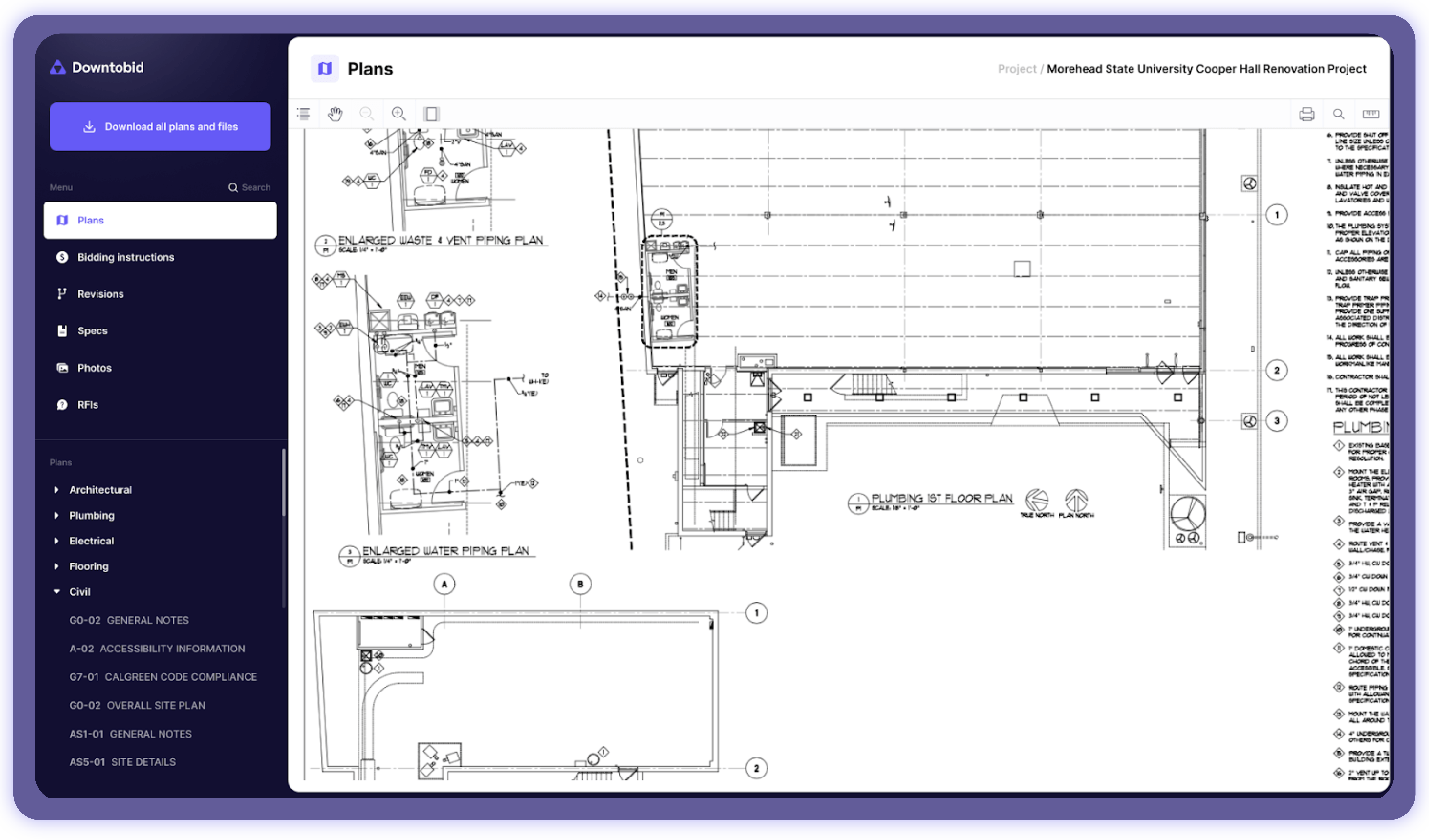
This approach has boosted collaboration and improved efficiency. It ensures everyone can access the latest construction plans and understand the requirements.
Now that we know what makes our software unique, let’s see how it works.

How to Use Downtobid
Here's a video walk through one of our co-founders, Andy Lee, made to show you how to use our tool.
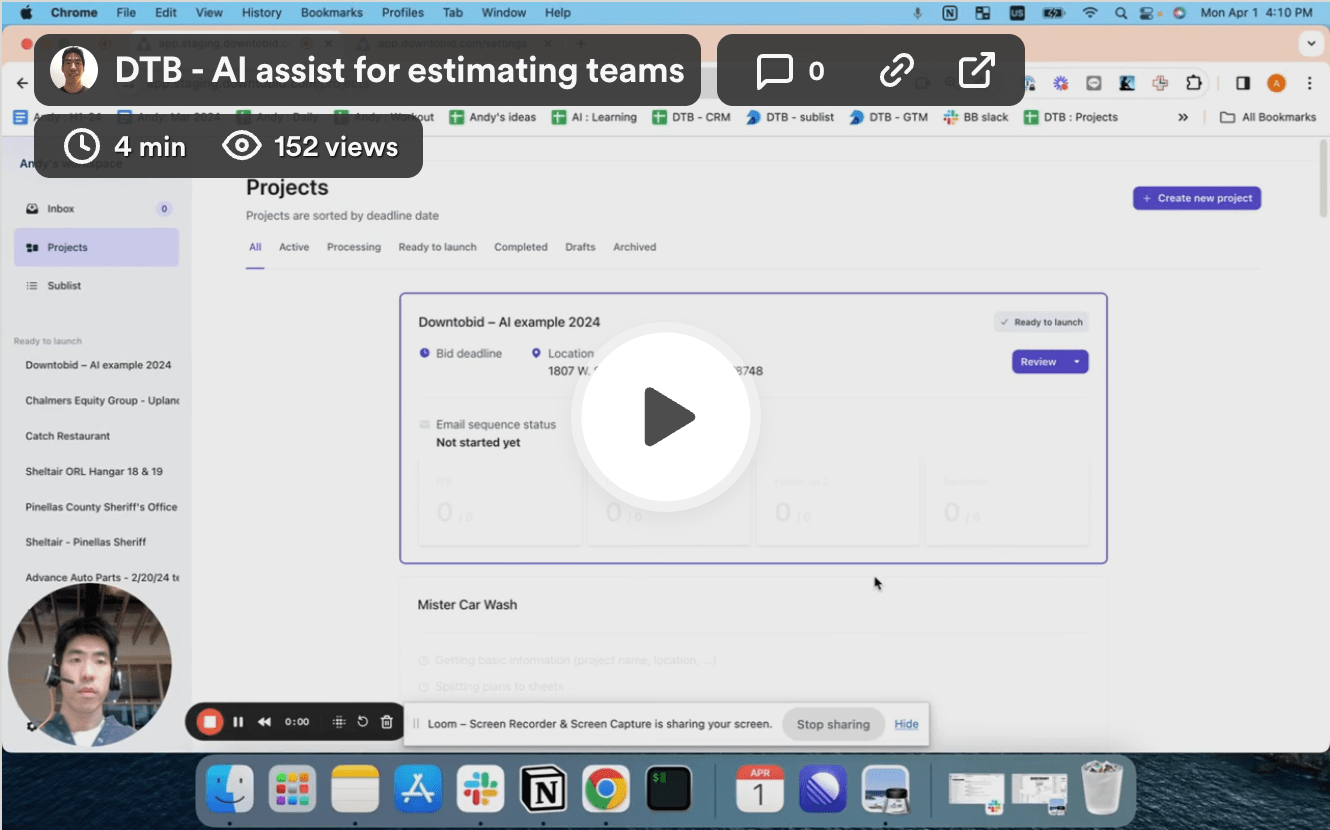
We'll also give you a quick run through here.
Click here to sign up for a demo.
Upload PDF project plans that don’t exceed 1GB.
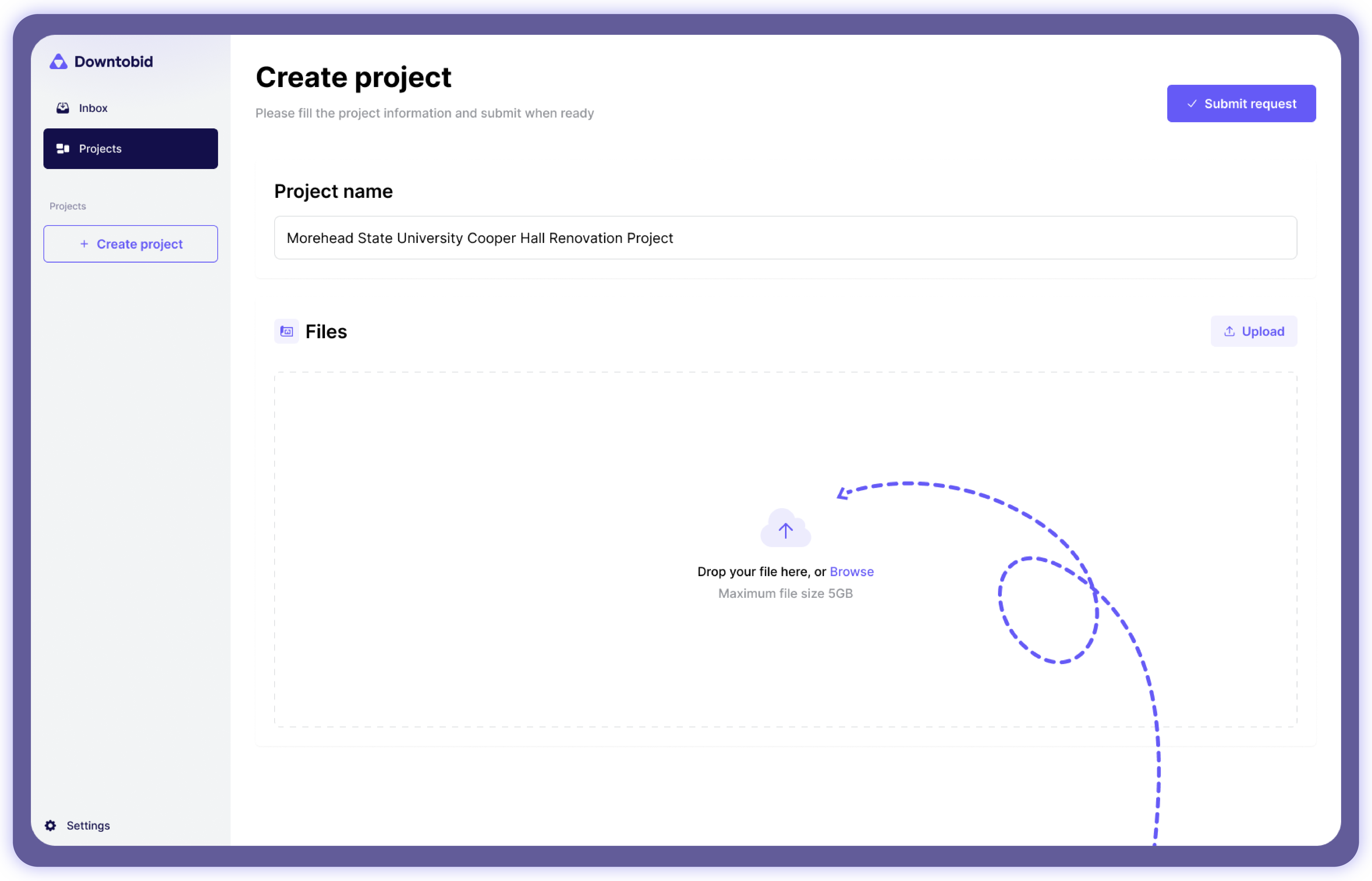
Wait for AI to scan the construction plans or documents and create bid packages with detailed scopes. The process takes about 10-30 minutes, depending on the project’s complexity. You’ll receive an email notification once the process is completed.
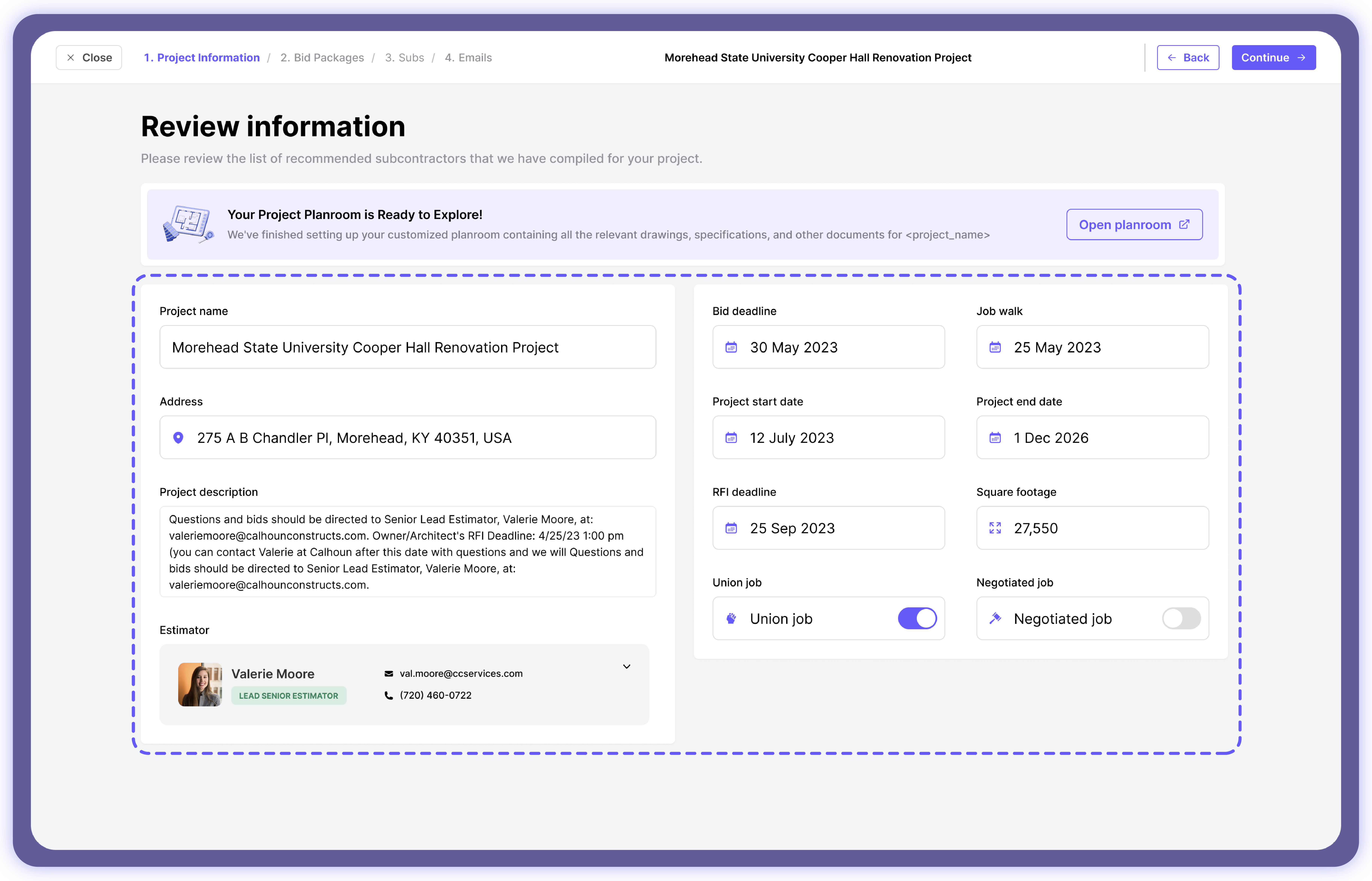
You must log in to the dashboard to access the generated bid packages. Here, you can review and edit the bid packages to match your desired tone.

Each bid package contains the following:
- A brief description of what’s inside each bid package.
- Every detected scope in the plans.
- A list of qualified local subcontractors you can contact.
Our system then suggests a bidding schedule, allowing you to target proposed subcontractors at opportune times. We discussed this under subcontractor recruitment. However, the process is straightforward. The system establishes the best time to send bid invites and follow-up emails.
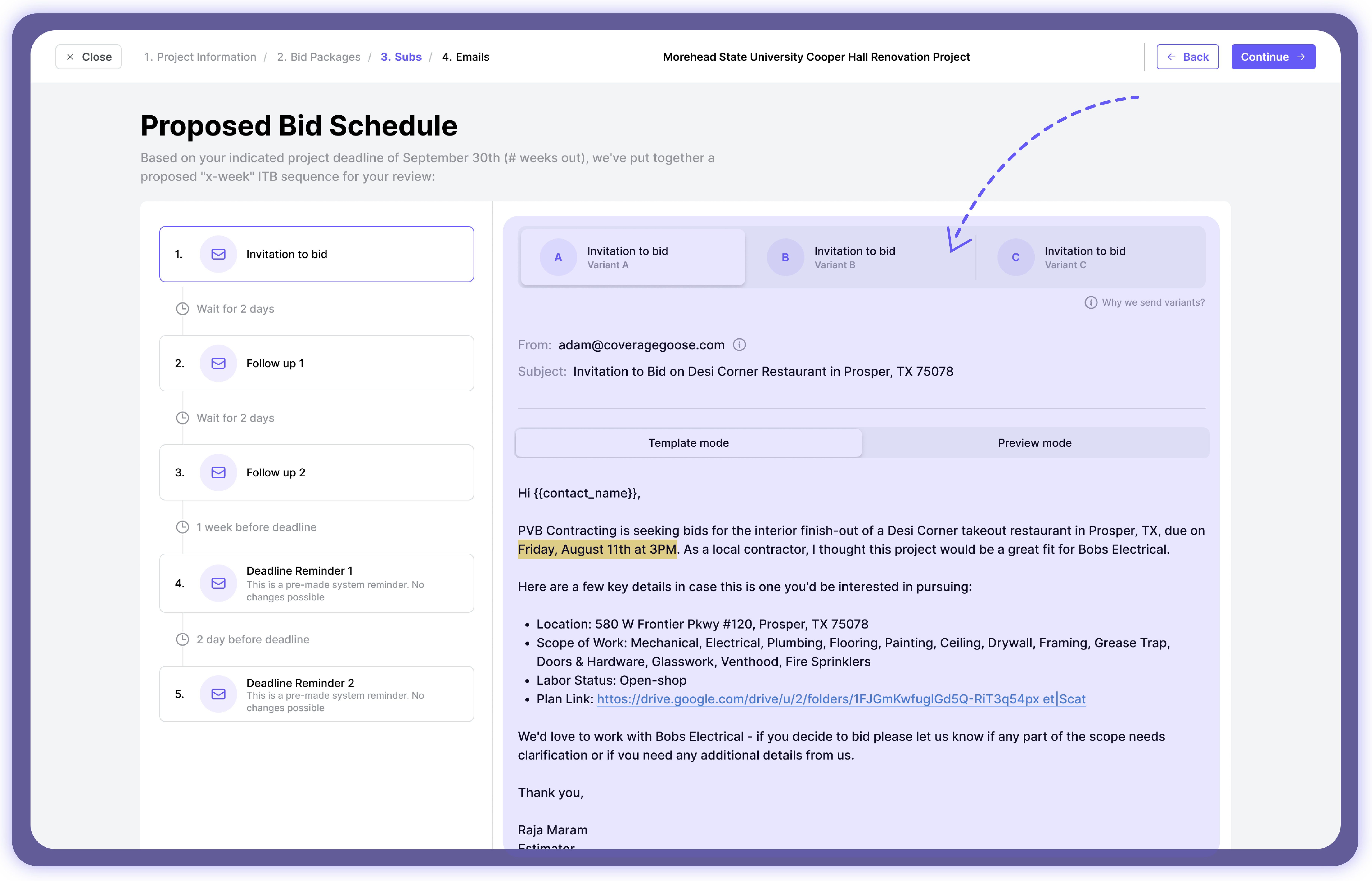
Each bid package contains details such as project name, location, budget, and timeline. Subcontractors use this information to determine if the project aligns with their interests.
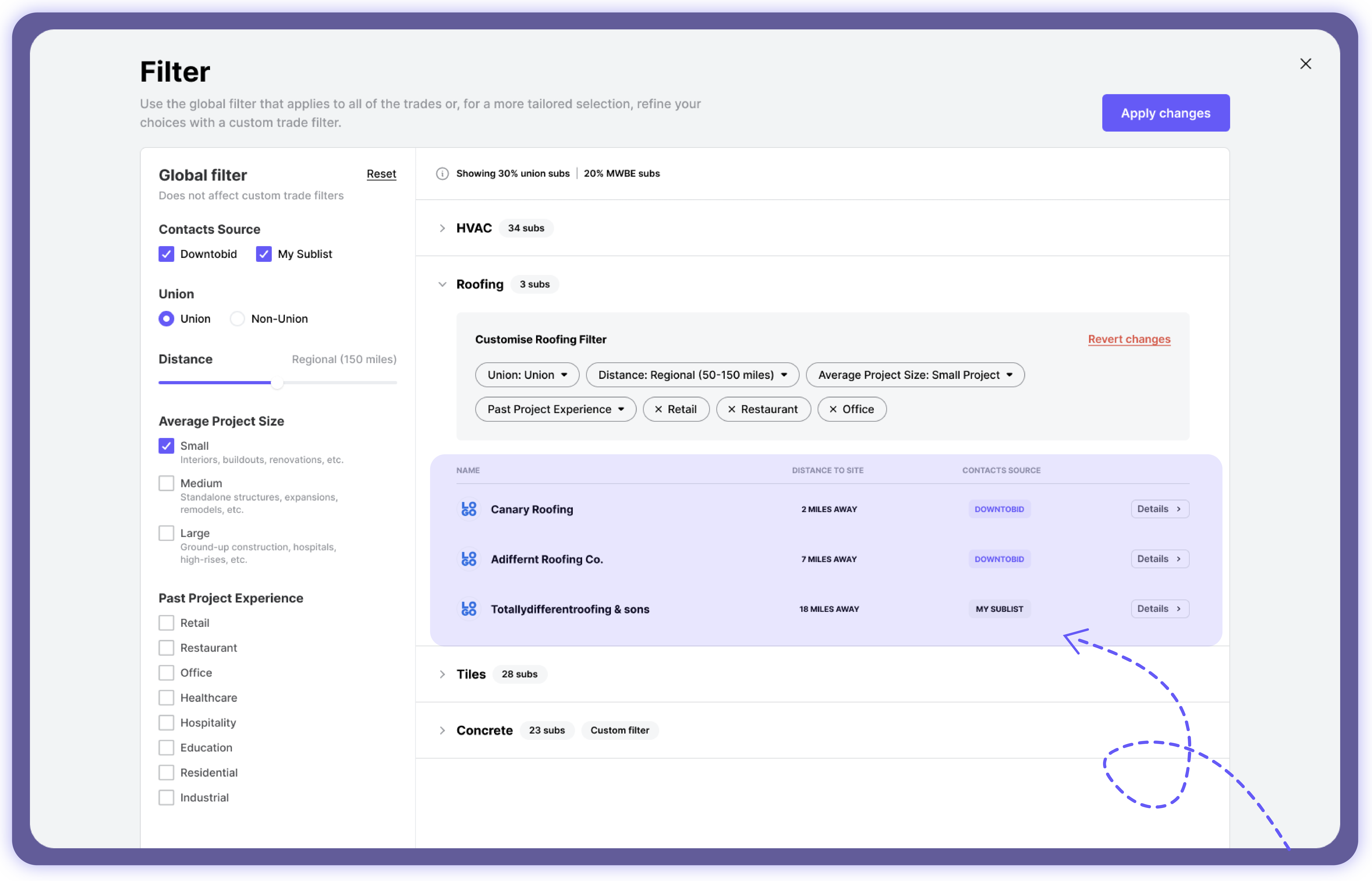
Our AI bidding software for GCs and subs stands out from the rest in the construction industry in many ways. First, it helps detect scope gaps to prevent miscommunication and errors. The success of any construction project is determined by accurate data and the team’s execution. Data misrepresentation, such as wrong measurements, often leads to undesired projects. Our AI fact-checks every data for accuracy and completeness.
Downtobid’s AI also helps create a construction team in minutes. Doing this manually is laborious and takes a long time. A project manager can allocate their precious time to other tasks, such as sourcing equipment and materials, instead of mass mailing potential subcontractors who might not respond.
Our AI has significantly reduced the workload of cost estimators. They don’t have to review construction documents to create estimates. The software scans through the documents and creates notes they can use to develop accurate construction estimates.
What is the Future of Artificial Intelligence in Construction?
AI is going to change how we build things and the entire construction industry. First, it will significantly reduce construction costs, as construction managers won’t require extensive teams to handle administrative tasks. Artificial intelligence will simplify project management.
We’ll also witness improved job site safety and collaboration, as artificial intelligence can detect potential construction site hazards and provide construction teams with accurate and real-time information.
The improvement of virtual reality goggles will eliminate the need to visit construction sites. Instead, project managers can track progress by sending drones with cameras under buildings on a construction site.
Although many people are worried about massive job losses in the construction industry, artificial intelligence won’t replace humans entirely. Instead, we’ll see hybrid construction sites where man and machine work toward a common goal. Construction companies that have started embracing artificial intelligence will be pioneering the technological evolution in the construction sector. There will be fewer errors and mistakes, and efficiency will be the cornerstone of every project.